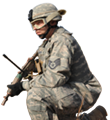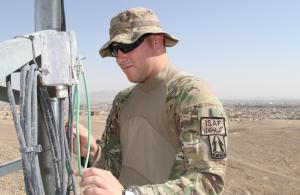Commo’ on the go
| DMNA Home page | More News Stories |
Story by: Cpl. Clay Beyersdorfer - 70th Mobile Public Affairs Detachment
Dated: Wed, Oct 16, 2013
KANDAHAR AIRFIELD, Afghanistan -- The bright red taillights of a white pickup truck illuminate another cold, dark and early morning at Kandahar Airfield, Afghanistan. The faint creaks and sounds of the wooden planks on the boardwalk echo into the black sky; no other vehicles are on the roads and, with the exception of few night shift personnel walking around, not many people to see this hour of the day.
Kandahar Airfield is a ghost town.
It is a typical early morning for that pickup truck and the three individuals inside of it, heading toward the airfield, off again on another mission.
This is the life of three airmen -- Capt. Michael Gielbeda, Staff Sgt. Hewitt Depass and Senior Airman Matthew Perry, who are part of the 213th Engineering Installation Squadron, 105th Airlift Wing, New York Air National Guard.
Their mission often requires many of these early mornings when the clock starts hours before the sun even comes up. Responsible for the installation of communication systems throughout Regional Command (South), Gielbeda, Depass and Perry are used to packing up, moving and being “on call.” The mission this particular morning involves flying to Forward Operating Base Maholic to test a connection of fiber strands between it and KAF, the main hub for many of the networks between bases across RC(S).
Gielbeda, who is the officer in charge of the 213th EIS, talked about the importance of communications across bases.
“It is extremely important that you are able to communicate, and that you have the technical support to do so,” Gielbeda said. “Without it, missions are not able to be conducted, and our work as a task force here comes to a halt.”
The team works with all types of units including special operations personnel, whose mission is heavily reliant on stable communication.
“When you work with those guys, communication is really important,” Gielbeda said. “If smaller FOBs cannot receive intelligence or mission updates, it becomes a concern. You cannot continue to conduct operations without it.”
Fiber optic strands stretched across RC(S) provide internet and the ability to connect communications systems and computer networks to smaller outposts and even large bases like KAF.
Those fiber strands form the “Afghan Fiber Ring,” which is close to 850 miles around, providing a capacity of one gigabit per second to each location on the ring.
One small tear in the wiring causes the whole system to fail. Depass talked about how tedious and important thorough maintenance is.
“Sometimes it can be a lot of waiting around when you are testing the connections and the hours can build up,” Depass said. “There are a lot of moving pieces to this whole process, and it is important to get all of them right.”
The relief of today is that no cracks or tears were found and all systems were up and running.
Despite today’s success, systems are not always up and running, and about six months ago, when they arrived on ground, many of these systems were not even in place.
“We almost had to basically start over in some places, digging trenches and physically laying cable and fiber optic strands in place,” Depass said.
After weeks of setting up new systems, it has taken a tremendous amount of work from not only Gielbeda, Depass and Perry.
That hard work has provided coalition forces with network access. Afghan government agencies, healthcare companies and private companies will also be able to use the fiber ring in the future, Gielbeda said.
“What we have been able to accomplish here in RC(S) is incredible,” Gielbeda said. “We have been on the go over the last six months and the amount of work needed to get where we are today was hard, but well worth it.”
He added that before the ring of fiber strands was put in place, each location had a max capacity of 30 megabits per second.
The speed the ring runs on now is up by 3400 percent. Gielbeda and his team spent more than two weeks at FOB Maholic, checking connections from all over and ensuring personnel on ground have what they need to accomplish the mission.
For Perry, the third member of this mobile team, when systems checks go well, there is no better feeling.
The bright red taillights of a white pickup truck illuminate another cold, dark and early morning at Kandahar Airfield, Afghanistan. The faint creaks and sounds of the wooden planks on the boardwalk echo into the black sky; no other vehicles are on the roads and, with the exception of few night shift personnel walking around, not many people to see this hour of the day.
“It is a big relief when communication is good to go across the board, when the strands haven’t been compromised and have maintained working ability,” Perry said.
After a long day of ensuring everything is “green,” the three engineers go over future operations and disseminate what needs to happen while they are on ground.
It is the home stretch for these three, as they are nearing the end of their tour and ready to head home, and they want to ensure before they leave, things are running the right way.
“You take pride in your work and the things you do,” Gielbeda said.
After being back and forth and all over Afghanistan the last six months, it is safe to say the team is ready to be in one spot for a while. “You know we have one of the coolest jobs I think,” Depass said. “Some of the things we get to do are amazing, but it’ll be nice to come home and enjoy some time off.”
Perry agreed.
“I’m ready to sleep in a little bit,” Perry said jokingly.
The white pickup has made its last early morning run.
Read more: http://www.dvidshub.net/news/115155/commo-go#ixzz2i4vFNFZw
URL: https://dmna.ny.gov/news/?id=1382101575
216.73.216.158
Page Last Modified: Fri, Oct 18, 2013




